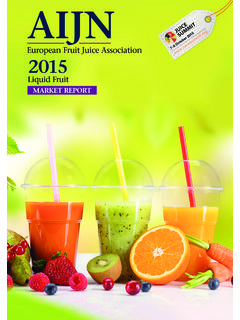Transcription of 11 Microbiology of soft drinks and fruit juices
1 11 Microbiology of soft drinks and fruit juicesP. Wareing and IntroductionSoft drinks and fruit juices represent an important market within the food increasing variety of products being released at a bewildering rate hasaltered the potential for spoilage problems. soft drinks are generally nutrient-poor media that are spoiled by relatively few organisms usually yeasts, and afew acid-tolerant bacteria and fungi. Carbonation shifts the spoilage flora tothose organisms tolerant of carbon dioxide. soft drinks enhanced by the addi-tion of low levels of fruit juice tend to exhibit similar spoilage flora to fruitjuices. The use of ever more exotic raw ingredients may lead to the discovery ofunusual spoilage organisms in the future. Yeasts in general, andZygosaccharomyces bailiiin particular, remain the key spoilage organismsbecause of their overall physiology and resistance to organic acid preservatives(Stratfordet al.)
2 , 2000).Microbial problems within soft drinks and fruit juices can be divided intotwo groups:(1) growth in, and deterioration of, the product by general organisms toproduce spoilage;(2) growth in, or contamination of, the product by pathogens to producefood have been relatively few instances of food poisoning in fruit juices orsoft drinks , but microbial spoilage is very common. The previous edition of thisbook contained an excellent review and practical guide to the identification ofspoilage problems in the soft drink industry by the late Professor Davenport(1998). The present review will therefore keep key parts of the previous text,enhancing it with recent data, and simplifying some of the information. Forexample, some new information on acid-tolerant bacteria such asAlicyclobacillus acidoterrestris, and data on the pathogens Escherichia coliO157:H7 and Salmonellaspp.
3 Within fruit juices , merit examination, as do somenovel processing Composition of soft drinks and fruit juices in relation to spoilageThere is a bewildering variety of soft drink and fruit juices for sale, and manymethods for their manufacture. soft drinks can be non-carbonated, carbonated,CHEMISTRY AND TECHNOLOGY OF soft drinks AND fruit JUICES280with or without added fruit juice , often with the addition of organic acidpreservatives. They can be filled on standard or clean fill lines. fruit juices , fruitjuice concentrates and fruit nectars may be fresh, unpasteurised and clean filled,or pasteurised, then hot, aseptic, or clean filled (Stratford et al., 2000; Stratfordand James, 2003). Recent technology using ultra-high pressure has been used toproduce cold pasteurised fruit juices . These have the advantage of a fresh juicemouthfeel, but with destruction of pathogens and the majority of spoilageagents, enhancing the shelf life of an essentially fresh product (Mermelstein,1999; Zook et al.)
4 , 1999).Simple soft drinks such as orangeade and lemonade are too acidic for thegrowth of most organisms, so that spoilage is generally by carbonation-resistantspecies such as Dekkera anomala(Stratford and James, 2003). Yeasts usuallyrequire a carbon source such as a hexose sugar, a nitrogen source such as aminoacids or ammonium salts, simple salts (phosphate, sulphate, potassium and mag-nesium ions), trace minerals and vitamins. Some yeasts have particular sugarrequirements; for example, utilise sucrose (Pitt &Hocking, 1997; Stratford et al., 2000).Sugars have a protective effect on the heat resistance of yeasts and bacteria;this is an important consideration at higher concentrations of sugar. soft drinksare often nitrogen poor and thus the addition of fruit juice greatly enhances thepotential for spoilage. Some yeasts, for example Dekkera bruxellensis, can usenitrate.
5 Phosphate levels are often low, trace minerals satisfactory, particularlyin hard water areas. The low pH value of soft drinks and fruit juices , pH (Table ), inhibits most bacteria, but leaves yeasts unaffected. In soft drinksTable of fruit and vegetable juice pH and risk organismsApproximateRisk organismspH and and , bacteria and OF soft drinks AND fruit JUICES281and fruit juices , oxygen levels are usually low, and CO2levels either low or veryhigh (in carbonated soft drinks ). Spoilage is therefore due to facultative anaerobes,organisms that can grow with or without oxygen. In carbonated drinks , mouldand bacterial growth is very unlikely as they are very sensitive to recent trend towards polyethylene terephthalate (PET) packaging pres-ents its own problems. Typically PET containers cannot be hot filled; around50 C is the upper temperature, although some recent types can be heated to85 C.
6 They are also permeable to oxygen (Rodriguez et al., 1992), which allowsthe growth of aerobic spoilage Background Microbiology spoilageMany micro-organisms are found in soft drinks as environmental or rawmaterial contaminants, but relatively few can grow within the acidic and low-oxygen environment. Yeasts are the most significant group of micro-organismsassociated with spoilage of soft drinks and fruit juices . Spoilage will be seen asthe growth and production of metabolic byproducts, for example, CO2, acid, andtainting compounds. As noted above, most spoilage is therefore by yeasts andmould species, with yeasts most important, and some spoilage is by acid-tolerant bacteria (Hocking & Jensen, 2001; Jay & Anderson, 2001). SourcesFruit and fruit juices are commonly contaminated with yeasts and moulds, oftenfrom insect damage. Fallen fruit should thus be avoided where possible, forall of the risks outlined below.
7 Sugars and sugar concentrates are commonlycontaminated with osmophilic yeasts, for example Growth is slow inconcentrated solutions, but one cell per container of diluted stock is enough tocause spoilage (Davenport, 1996). Flavourings, water and other chemicals areall potential sources of microbial contamination. Process machinery and fillinglines are particularly problematic and strict hygiene is YeastsThere are over 800 species of yeasts currently described (Barnett et al., 2000),but only about 10 are commonly associated with spoilage of foods prepared infactories operating good standards of hygiene and using correctly applied chem-ical preservatives (Pitt & Hocking, 1997). Others are found if something goeswrong during manufacture; for example, incorrect preservative level, poorhygiene or poor-quality raw AND TECHNOLOGY OF soft drinks AND fruit JUICES282 Davenport (1996, 1997, 1998) describes a simple classification scheme foryeasts causing spoilage in the soft drinks industry, which, for investigative pur-poses, is used in Sections and and Appendices in this chap-ter.
8 He found that the yeasts isolated could be divided into four categories:Groups 1 4. Group 1 yeasts are described as spoilage organisms that are welladapted to growth in soft drinks , able to cause spoilage from very low cell num-bers (as few as one cell per container). The characteristics of Group 1 yeasts areosmotolerance, aggressive fermentation, resistance to preservatives (particularlyweak organic acids) and a requirement for vitamins. a typical exampleof this group, and this group corresponds closely with Pitt and Hocking s (1997)10 key spoilage yeasts. Davenport describes Group 2 organisms asspoilage/hygiene types, able to cause spoilage of soft drinks , but only if some-thing goes wrong during manufacturing, for example, too low a level (orabsence) of preservative, ingress of oxygen, failure of pasteurisation or poorstandards of hygiene.
9 Group 2 organisms are common contaminants in factories,but can be severely restricted if good manufacturing practices (GMP) areadhered to strictly. Group 3 organisms are indicators of poor hygiene yeasts will not grow in soft drinks , even if present in high numbers, andare typical of the yeasts found in many factories; the higher the count, the worsethe hygienic state of the factory. Group 4 yeasts, called aliens by Davenport,are those out of their normal environment. An example would be Kluyveromyceslactis, a dairy spoilage yeast. Table details the most common organisms ineach of yeast species found in soft drink factory environmentsGroup 1 Fermentation Group 2 Spoilage andGroup 3 HygieneGroup 4 Aliensand preservative resistance hygieneDekkera anomalaCandida davenportiiAureobasidium Kluyveromycespullulansmarxianus(dairy yeast)D. bruxellensisC.
10 ParapsilopsisCandida sakeK. lactisD. naardenensisDebaryomyces hanseniiC. solani(dairy yeast)Saccharomyces cerevisiaeHanseniaspora uvarumC. tropicalis(atypical strains)S. exiguusIssatchenkia orientalisClavispora lusitaniaSchizosaccharomyces Lodderomyces Cryptococcus albiduspombeelongisporusZygosaccharomyce s bailiiPichia anomalaC. laurentiiZ. bisporusP. membranifaciensDebaryomyces etchellsiiZ. lentusSaccharomyces bayanusRhodotorula glutinisZ. rouxiiS. cerevisiaeR. mucilaginosaSources: Based on Davenport (1996); Stratford & James (2003). Microbiology OF soft drinks AND fruit JUICES283 One of the most confusing aspects of mould and yeast taxonomy is thefrequency with which names are changed. Many yeasts and moulds havesexual and asexual stages that may have different names. Sometimes, theassociation of a yeast with a particular genus is recognised as wrong, and aname change then occurs.





